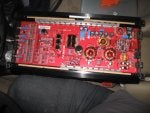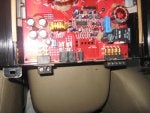I bought an old Orion XTR PRO 1000. I found very little about this amp anywhere other than the specs. Im guessing its an early Class D due to its huge size. Im also guessing its age to be 1999-2000?
My question is should I feel safe using this amp as its old and an early class D. Front the looks it seems heavy duty maybe even over built but I just don’t know.
I dont feel safe just hooking up this king of beast unless I get a little feedback from some people who are more in the know about this era of Orion early class D.
Its specs says 1000 watts at 1 ohm, 500 @ 2 ohm, 250 @ 4 ohms.
I can wire my pair of JL AUDIO 12W6V2 to 1 ohm or 4 ohms.
So my dilemma is 250 @ 4ohms isn’t near enough and 1000 at 1ohm might be good yet a tad to much but that can be cut back with gains etc...
BUT at 1 ohm I have no clue what kind of current this amp will draw or the efficiency.
Can anyone please give me any experiences with this amp or any background knowledge with the ORION XTRPRO 1000?
I attached images of the guts I took and the one of the heatsink I pulled off the net.
![]()
![]()
![]()
My question is should I feel safe using this amp as its old and an early class D. Front the looks it seems heavy duty maybe even over built but I just don’t know.
I dont feel safe just hooking up this king of beast unless I get a little feedback from some people who are more in the know about this era of Orion early class D.
Its specs says 1000 watts at 1 ohm, 500 @ 2 ohm, 250 @ 4 ohms.
I can wire my pair of JL AUDIO 12W6V2 to 1 ohm or 4 ohms.
So my dilemma is 250 @ 4ohms isn’t near enough and 1000 at 1ohm might be good yet a tad to much but that can be cut back with gains etc...
BUT at 1 ohm I have no clue what kind of current this amp will draw or the efficiency.
Can anyone please give me any experiences with this amp or any background knowledge with the ORION XTRPRO 1000?
I attached images of the guts I took and the one of the heatsink I pulled off the net.








